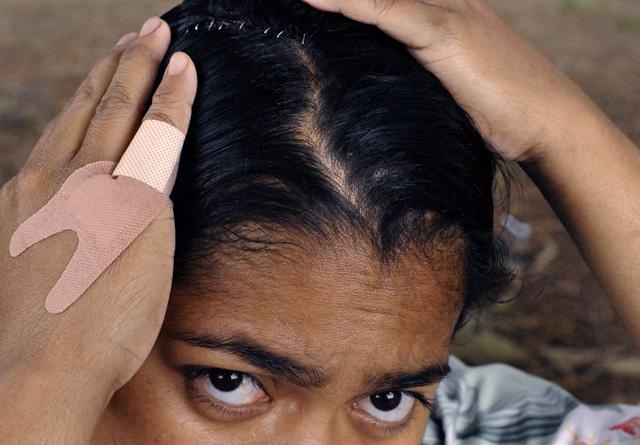Intimate Partner Violence: Behind the new DOJ Numbers
As Congress debates reauthorization of the Violence Against Women Act, a new DOJ report shows a dramatic drop in IPV incidence. But are the numbers accurate?

A bruised cheek. A broken bone. Nasty text messages. A window shattered in an effort to intimidate. These are signs of what is known as Intimate Partner Violence, or IPV. In the U.S., hundreds of thousands of incidents of violence between partners took place last year, but according to a recently released Justice Department report, the rate of IPV has declined by 64 percent between 1994 and 2010. Among Hispanic females, it went down 78 percent.
The report’s findings parallel the nationwide drop in violent crime, which over the same 18-year period declined by 47 percent. Many experts on the subject cite a broad shift in attitudes that began in the 1980s and '90s that involved public awareness campaigns and national legislation protecting victims. It also included training of police and prosecutors to treat intimate partner violence not as a private matter but a crime.
But while the figures show progress, they may not reflect the whole story.
The Justice Department report is based on data from the National Crime Victimization Survey, an assessment that is made through in-person interviews conducted twice a year, over as many as three years. In what appears to be an effective approach, the interviews are not done just with individuals but with multiple members of a household. This way, researches are able to glean, and include, data about incidents of IPV not reported to the police. According to another Justice Department study, nearly 46 percent of cases of IPV between 2006 and 2010 were not reported, often because victims feared retaliation or didn't want the offenders to get in trouble.
But what the new DOJ report doesn’t reflect is data from individuals who are homeless or who live in mental institutions or military barracks, where rates of IPV may be noticeably higher. Independent research, discussed at a 2011 Dart Center workshop on Intimate Partner Violence, suggests that in American cities, between 20 and 40 percent of homeless parents reported having left their home because of violent disputes.
When asked about the new report, Toni Jones, a program services manager at an emergency shelter for single women and families in Boston, said she had not recognized a decline in IPV. "What I see again and again is not enough space for women and children fleeing violence,” Jones said. Casa Myrna, the emergency shelter where she works, has ten beds, which are almost always full. Jones tries to link women in need, sometimes from neighboring states, with open beds across Massachusetts through a 24-hour statewide hotline operated by Casa Myrna, called Safelink.
“What we’re seeing could be a consistent underestimate of how many people have been victims of domestic violence,” due to the lack of data on the homeless,” said Callie Rennison, a victimologist and associate professor at the University of Colorado Denver. Though she noted the Justice Department’s statistics may be more accurate than police data, for the sole reason that it accounts for unreported crimes. Regarding the significant drop in Hispanic victims of IPV, Rennison noted that while there is very little literature on the victimization of Hispanics in the United States, income is generally a more important indicator for IPV than race.
Shannan Catalano, who wrote the Justice Department report, said it was normal that those working directly with victims don’t always see the same thing that statistics reveal. The local level “doesn’t necessarily reflect what we see at the national level,” she says. For example, if a shelter's 100 beds are always full, there is no visible decrease in victimization. But “the number is declining," says Ms. Catalano. "It’s just not dipping below the number of beds available.”
There is mounting evidence that the risk of domestic violence is reduced for women in communities where per-capita levels of police and social service providers are relatively high, according to a November 2012 study in the journal Criminology. As cities and states confront budget pressures in a lackluster economy, cuts to police departments and social services could result in more IPV victims, some analysts say.
That is why many victim advocates are pushing for the reauthorization of the Violence Against Women Act (VAWA), which was passed by the U.S. Senate this week and faces an upcoming battle in the House. The bill would provide $659 million in funding over five years for programs for victims of violence and abuse. VAWA funds police IPV sensitivity trainings, as well as legal services such as issuing restraining orders and representation for victims. Perhaps more important, VAWA provides momentum for states to adopt mandatory arrest laws governing cases in which police suspect domestic violence, based upon evidence and probable cause. And though controversial because of the potential impact on a victim’s willingness to report incidents of IPV, these laws now exist in 22 states and the District of Columbia. Incidents against women comprised about 80 percent of IPV cases in 2010, according to the Department of Justice report.
“I’m willing to speculate [that] VAWA had a direct impact" on reducing intimate partner violence between 1994 and 2010, says Joan Meier, professor of clinical law and director of George Washington University’s Domestic Violence Legal Empowerment and Appeals Project. Meier noted that the IPV decline began the same year the that the VAWA was first signed into law. “Because of VAWA it became more widely understood that this violence is a crime and is unacceptable.”

































































































